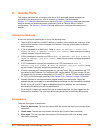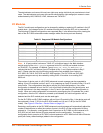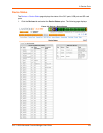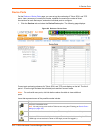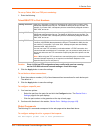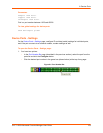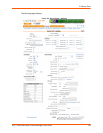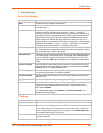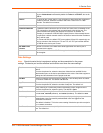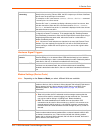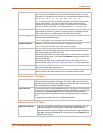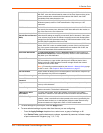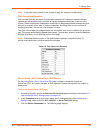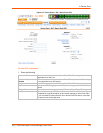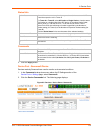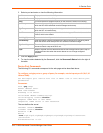
8: Device Ports
SLC™ 8000 Advanced Console Manager User Guide 108
Data Settings
Note: Check the serial device’s equipment settings and documentation for the proper
settings. The device port and the attached serial device must have the same settings.
Authentication If selected, the SLC unit requires user authentication before granting access to
the port. Authenticate is selected by default for Telnet in and SSH in, but not for
TCP in.
Timeout To cause an idle Telnet, SSH or TCP connection to disconnect after a specified
number of seconds, select the checkbox and enter a value from 1 to 1800
seconds. The default is no timeout.
Seconds Number of seconds before a timeout.
IP Address/Netmask
Bits
IP address used for this device port so a user can Telnet, SSH, or establish a raw
TCP connection to this address and connect directly to the device port. The
optional netmask bits specify the netmask to use for the IP address. For
example, for a netmask of 255.255.255.0 specify 24 bits. If the netmask bits are
not specified, a default netmask used for the class of network that the IP address
falls in will be used.
For Telnet and SSH, the default TCP port numbers (22 and 23, respectively) are
used to connect to the device port. For raw TCP, the TCP port number defined
for TCP In to the device port is used.
Web SSH/Telnet
Columns
Number of columns in the Web SSH/Telnet applet when this device port is
accessed via the applet.
Rows Number of rows in the Web SSH/Telnet applet when this device port is accessed
via the applet.
Baud The speed with which the device port exchanges data with the attached serial
device.
From the drop-down list, select the baud rate. Most devices use 9600 for the
administration port, so the device port defaults to this value. Check the equipment
settings and documentation for the proper baud rate.
Data Bits Number of data bits used to transmit a character. From the drop-down list, select
the number of data bits. The default is 8 data bits.
Stop Bits The number of stop bit(s) used to indicate that a byte of data has been transmitted.
From the drop-down list, select the number of stop bits. The default is 1.
Parity Parity checking is a rudimentary method of detecting simple, single-bit errors.
From the drop-down list, select the parity. The default is none.
Flow Control A method of preventing buffer overflow and loss of data. The available methods
include none, xon/xoff (software), and rts/cts (hardware). The default is none.
Enable Logins For serial devices connected to the device port, displays a login prompt and
authenticates users. Successfully authenticated users are logged into the
command line interface.
The default is disabled. This is the correct setting if the device port is the endpoint
for a network connection.
Max Direct Connects Enter the maximum number (1-10) of simultaneous connections for the device
port. The default is 1.



